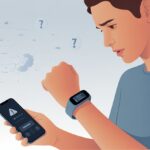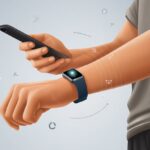Let’s be honest—sometimes, we spend more time scrolling through our phones at the gym than actually lifting weights. That’s where fitness trackers can save us from ourselves and help us focus.
With a fitness tracker, we can easily log our sets, reps, and rest times. Weightlifting gets smarter and involves a lot less guesswork.

We don’t need to be tech geniuses to get started. Most trackers let us pick “weightlifting” mode, record important stats, and keep track of our workouts better than our sweaty brains ever could.
If you’re curious about the best ways to use a tracker for lifting, or which devices and apps actually work, you’ll find guides and reviews that break down why some options—like Whoop 4.0—rise to the top for weightlifting and gym workouts.
So, whether we’re deadlifting like superheroes or just trying not to drop dumbbells on our toes, knowing how to use a fitness tracker means we can finally stop guessing and start making real progress.
Let’s dive in and make those numbers actually count for something.
Choosing the Best Fitness Tracker for Weightlifting
Let’s be real—picking a fitness tracker for the gym feels more confusing than decoding protein powder labels. We want to make it simple by focusing on features, comparing brands, and making sure we’re not emptying our wallets—or forgetting a charger every other day.
Key Features to Consider
Before we get distracted by fancy screens, let’s focus on what really matters:
- Reps and Sets Tracking: Some trackers just don’t get weightlifting. We need devices that recognize strength exercises, and it’s even better if they count reps automatically.
- Heart Rate Monitoring: Reliable heart rate readings matter, especially during those “one last set” moments.
- Durability: Sweat, chalk, and the occasional kettlebell drop happen. We need a tracker that’s as tough as our motivation.
- Ease of Use: If logging a workout takes longer than finishing one, forget it. Touchscreens and big buttons are lifesavers.
- Syncing and Compatibility: Our tracker should play nice with our phones and apps—even if we switch devices as often as we switch playlists.
Comparing Popular Brands
Let’s throw the big names into the ring and see how they stack up:
| Brand | Best For | Notable Features |
|---|---|---|
| Garmin | Data lovers & lifters | Advanced rep counting, durability |
| Apple Watch | Smartwatch fans & casual lifters | Customizable apps, great display |
| Fitbit | Simplicity & long-term tracking | Sleep tracking, user-friendly |
| Whoop | Tracking recovery & strain | No display, great analytics |
| Push Band | Weightlifting focus | Movement analysis, wearable sensor |
Garmin’s trackers, like the Forerunner line, often get praise for weightlifting accuracy and a tough build. The Whoop 4.0 stands out for recovery data, though it skips the screen to keep distractions down.
Fitbit and Apple Watch offer a mix of smart features and activity tracking. Push Band? It’s all about form and reps.
Budget and Battery Life
None of us want to buy a tracker just to watch our cable bill rise. Finding something affordable feels almost as good as hitting a new PR.
Entry-level fitness trackers give us basic tracking and solid battery life, but might miss out on fancy strength metrics.
Pricey smartwatches like the Apple Watch do almost everything—including reminding us to stand up—but they need regular charging. Garmin usually wins in battery life, with some models lasting up to a week. For those who hate plugging in gadgets, that’s kind of a miracle.
Garage Gym Reviews points out that many top trackers now balance price, features, and battery life. That means we get to spend more time lifting and less time searching for a charger (or spare change).
Setting Up Your Fitness Tracker
Strapping on that fitness tracker is only the first step. If we want to track every deadlift, bicep curl, and maybe even our failed bench press attempts, we need to sync and personalize things a bit.
Setting up matters just as much as the workout if we want to see the right stats and have a complete record in apps like Garmin Connect or Apple Health.
Pairing with Your Smartphone
First up, let’s get our tracker and phone talking. We usually power up Bluetooth and make sure our phones are in “find me” mode. Then, we head to the brand’s app—no, yelling at the screen won’t make your Garmin sync faster (tried it, didn’t work).
Pairing usually goes like this:
- Open the fitness tracker app (like Garmin Connect or Apple Health).
- Follow the steps to pair your watch or band over Bluetooth.
- Wait for confirmation—maybe a buzz, a cha-ching, or an overly cheerful notification.
- Sync right away so the device and app match. If we skip this, our first workout might disappear into the digital void—never counted.
Once we’re connected, we can see our workout data right on our phones, not just squinting at tiny wrist text. It’s way easier to review stats, share records, or brag a little.
Customizing Weightlifting Workouts
Let’s take charge of how our tracker logs workouts. Most trackers let us choose types like “Strength Training” or “Weightlifting.” Setting this right means our tracker counts reps (or at least tries—sometimes it thinks a dumbbell curl is a dance move).
Here’s what we can tweak for better results:
- Pick the specific workout type, not just “Other.”
- Add details like weight used, sets, and rest times in the app or on the tracker.
- Some devices let us fix rep counts or add notes if the tracker miscounts—we don’t need “ghost reps” inflating our stats.
- On Garmin Connect, we can create custom exercises, save routines, or adjust rest periods. Apple Health isn’t as detailed, but still lets us log the basics.
If we customize, we get accurate tracking, better insights, and fewer surprises when we compare the data with how sore we feel the next day.
Tracking Workouts for Weightlifting
When we use a fitness tracker during weight training, we want to squeeze every bit of value from its features. Tracking sets, reps, and weights accurately helps us see our progress and avoid losing our place mid-workout (yeah, we’ve all stood there thinking, “Was that set three or four?”).
Using Workout Modes
First, we need to pick the right workout mode. Most good trackers offer a “strength training” or “weightlifting” mode.
Some devices even have a special Strength activity profile built for tracking reps, sets, and exercise types.
When we use workout modes, the tracker logs useful data for us: calories burned, heart rate, total sets, and sometimes even the weight used.
Some wearable trackers buzz to remind us to start or end a set—which, honestly, is helpful when we’re too busy flexing in the mirror to watch the clock.
Trackers like the Apple Watch let us manually select workout types, so our bench press doesn’t get confused with “powerwalking to the squat rack.” Custom modes help us match the exact strength workout we’re doing.
Logging Sets and Reps
Consistency makes us stronger—and it helps to remember what we lifted last time. Most fitness trackers let us log sets, weight, and count reps for each set, either through the device or a phone app.
Garmin watches let us tap out sets and reps right on our wrist, so we don’t have to trust our memory (which, let’s be honest, gets sketchy after leg day).
Some trackers try to auto-count reps, but sometimes they think we’re stronger—or weaker—than we really are.
Tables and lists in the app help us spot trends. We can track total reps, weight progression, and figure out where our form went south—usually somewhere between the first and last set.
Set timers also keep us from cutting rest periods short just because we’re bored scrolling memes.
Rest Timing and Recovery Insights
Getting rest timing right can mean the difference between smashing a new PR or just struggling to open our protein shaker. Managing rest periods with a fitness tracker keeps us from slacking—or resting so long we forget what exercise we’re on.
Setting Rest Timers
Most fitness trackers have a rest timer feature, so we can keep our rest periods consistent. We can set a timer for 60 or 90 seconds, depending on how ambitious (or tired) we feel.
This keeps us focused and helps avoid endless phone scrolling between sets.
Wearables like Garmin watches let us start the timer right after a set with a button or tap. Some apps let us set a default rest time for all exercises, so we spend less time fiddling with settings and more time actually lifting.
Using rest timers lowers our risk of injury, since proper recovery helps us keep good form and perform at our best. Plus, it’s tough to skip hard sets when our wrist buzzes us back to reality like a tiny, judgmental coach.
Monitoring Performance and Metrics
We all want to know if our sweat in the gym actually matters—besides making laundry piles grow. Tracking weightlifting performance with a fitness tracker gives us real numbers, not just sore muscles and stories.
It helps us focus on the details that actually count.
Analyzing Calories Burned
Let’s be real—lifting weights doesn’t always leave us winded like a sprint, but we still burn a fair amount of calories. Most fitness trackers figure out calories burned by mixing up our heart rate, age, weight, and how tough our workout feels.
The numbers aren’t perfect, but they help us see if we’re cutting calories, maintaining, or about to demolish a pizza without guilt. Tracking calories burned lets us tweak what we eat, whether we’re aiming to lose fat or build muscle.
Some trackers even let us log sets and reps, which makes it easier to see how challenging our routine really is. If you’re eyeing a tracker, it’s worth checking which ones have solid calorie tracking—it can make the stats a lot more trustworthy.
Heart Rate Monitor Insights
We don’t have to guess if our workout is “hard enough” anymore—a heart rate monitor shows us the truth. Watching our heart rate during sets and breaks reveals exactly how our body reacts to lifting, set after set.
Tracking heart rate zones helps us chase personal bests, not just wishful thinking. We can tell if we’re actually pushing ourselves or just scrolling memes between sets.
Most trackers show our max, average, and recovery heart rates. Heart rate alerts keep us from overdoing it (or phoning it in), so our training stays both safe and effective.
Some trackers even suggest rest intervals based on how our heart responds. That way, we’re not just guessing when to get back under the bar.
Metabolic Rate Tracking
Metabolic rate—basically, how many calories we burn just by existing—is pretty much the only goal some days. Fitness trackers usually estimate our Basal Metabolic Rate (BMR) using our age, gender, weight, and height.
This helps us figure out what we actually need to eat, which is honestly more interesting than reading cereal labels. By tracking both our workouts and metabolic rate, we finally see the “big picture” of our calorie balance.
That means we know if it’s time for another protein shake or maybe a salad. Good wearables crunch these numbers for us, making it easier to make smart choices about recovery and nutrition.
Some trackers even include active calories from weight training on top of our daily metabolic totals. That’s actually pretty useful.
Advanced Sensors and Technology
Our fitness trackers used to just count steps. Now? They’re basically tiny science labs on our wrists.
These gadgets use advanced sensors to keep tabs on everything we do at the gym—even when we try to sneak a break.
Accelerometer and Gyroscope Functions
Let’s shout out the real MVPs of gym tech: accelerometers and gyroscopes. The accelerometer is kind of like an over-caffeinated dance coach, tracking how fast and in what direction our arm moves each rep.
The gyroscope tracks our angle and rotation, so the tracker knows if we’re actually lifting that dumbbell or just waving at someone. When they team up, these sensors count reps, measure bar speed, and even help us fix our form.
Check out this guide to bar speed trackers for more details.
Here’s what these sensors do for us:
- Rep counting: They know when a rep starts and ends—even if we sneak in a half-rep.
- Form tracking: They catch us cheating, so there’s no hiding a bad squat.
- Speed monitoring: Now we see just how fast (or slow) we’re moving the weight.
With these sensors, there’s no fudging the numbers. Our tracker always knows what’s up.
Integrating with Other Workout Types
Fitness trackers don’t just care about weightlifting. They switch to running, cycling, or whatever else we’re up to, so we don’t have to guess how many calories we burned wrestling with the bike rack.
Switching Between Strength and Cardio Modes
Sometimes we wonder, “Should I lift or just run away from my problems today?” Most trackers let us switch modes in a few taps, which is a lifesaver for anyone who likes both lifting and getting their heart rate up.
Some, like Garmin, have special strength training profiles. We can log sets, reps, and weights, then swap to cardio mode if we’re sprinting for the bus (again).
No more scribbling everything in a notebook like it’s 1999. Switching modes isn’t just handy—it helps us track each activity accurately.
We get better calorie counts and avoid logs that make it look like we ran a marathon on leg day. This also helps when syncing with apps like Strava, which sometimes double-log activities if we’re not careful.
If you want to see how people handle Garmin and Fitbod integration, there’s a whole thread about it.
Using Trackers for Running and Cycling
If we’re part-time cyclists or weekend runners, fitness trackers are totally up for it. Most have modes for running, cycling, and sometimes activities that should just be called “tripping over nothing.”
Trackers like Fitbit or Apple Watch do a solid job capturing routes, speed, and heart rate for runs. For cycling, they log distance, pace, and elevation—perfect for bragging or justifying that extra snack after a ride.
If our tracker has GPS, we can see exactly where we looped around the same block three times because we got lost. Cyclists can check their real speed (not just the number they tell their friends).
Tracking all this in one place helps us spot trends and shake up our routines. It keeps workouts fresh and makes sure we’re actually getting stronger and not just pretending.
If you want more tips on tracking these activities, here’s a guide for using fitness trackers.
Setting and Smashing Fitness Goals
We all want those gym gains, but let’s be honest—without a plan, we’ll just end up lifting snacks. A fitness tracker helps us chase lifting goals, track weight loss, and make sure our effort isn’t wasted.
Tracking Progress Over Time
Most of us forget what we lifted last week. Was it the bar, or just our dignity? Fitness trackers remember for us.
By logging each workout, we see sets, reps, and weights for every exercise. Many trackers and apps let us set specific targets.
For example:
| Goal Type | Example |
|---|---|
| Strength | Deadlift 200 lbs by August |
| Weight Loss | Lose 10 lbs in three months |
| Consistency | Lift four days a week |
These numbers keep us honest. With historical data and progress graphs, we can spot what’s working—and what’s not.
Adjusting weight or reps is way easier when we see the big picture. If we’re not making progress, the tracker doesn’t lie. It just lets us know, sometimes a little too honestly.
Motivation and Sticking to Your Plan
Motivation feels a lot like a protein bar—awesome at first, but it can disappear if you’re not paying attention. Fitness trackers toss us reminders, hand out achievement badges, and send those weekly reports so we remember why we’re sweating at the gym instead of just zoning out in front of the TV.
You can compete with your past self or even go head-to-head with friends. Most trackers let you share milestones or jump into online challenges, which honestly gives your willpower a nice little boost. Sometimes it even sparks a bit of friendly rivalry.
If you tweak your tracker’s goals or notifications, you won’t burn out trying to deadlift like a superhero on your first day (customization tips here).
When you check in regularly and see your progress, that gadget on your wrist turns into your own digital hype squad. It cheers you on every set and every step.
- How to use a fitness tracker for weightlifting: Because Your Biceps Deserve More Data - November 15, 2025
- How to Use a Fitness Tracker as a Camera Remote: Snap Pics While Counting Steps - November 15, 2025
- Smartwatch Error Code 1001 Fix: When Your Wrist Decides It Needs a Sick Day - November 14, 2025






